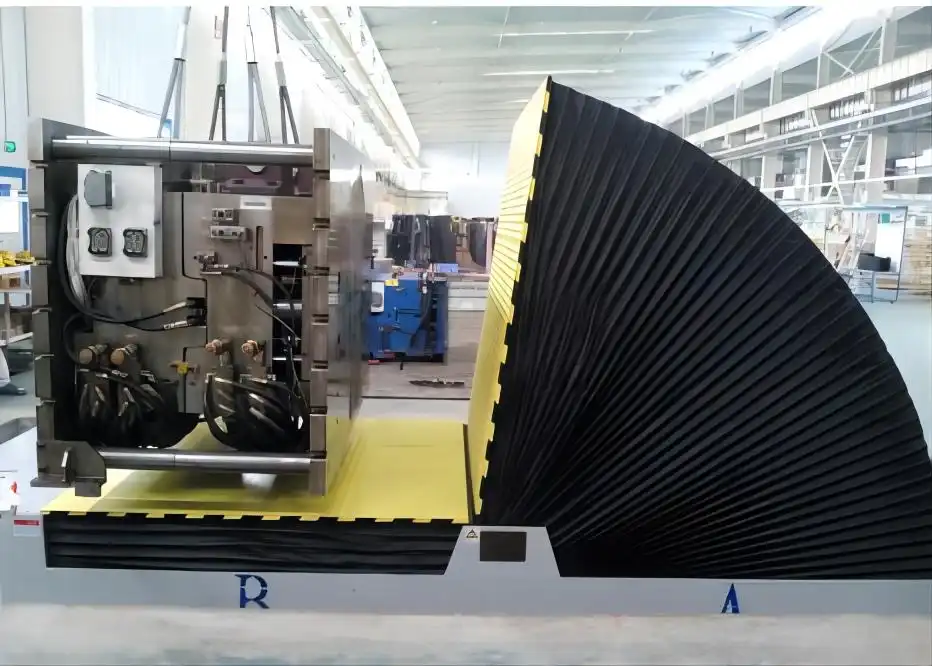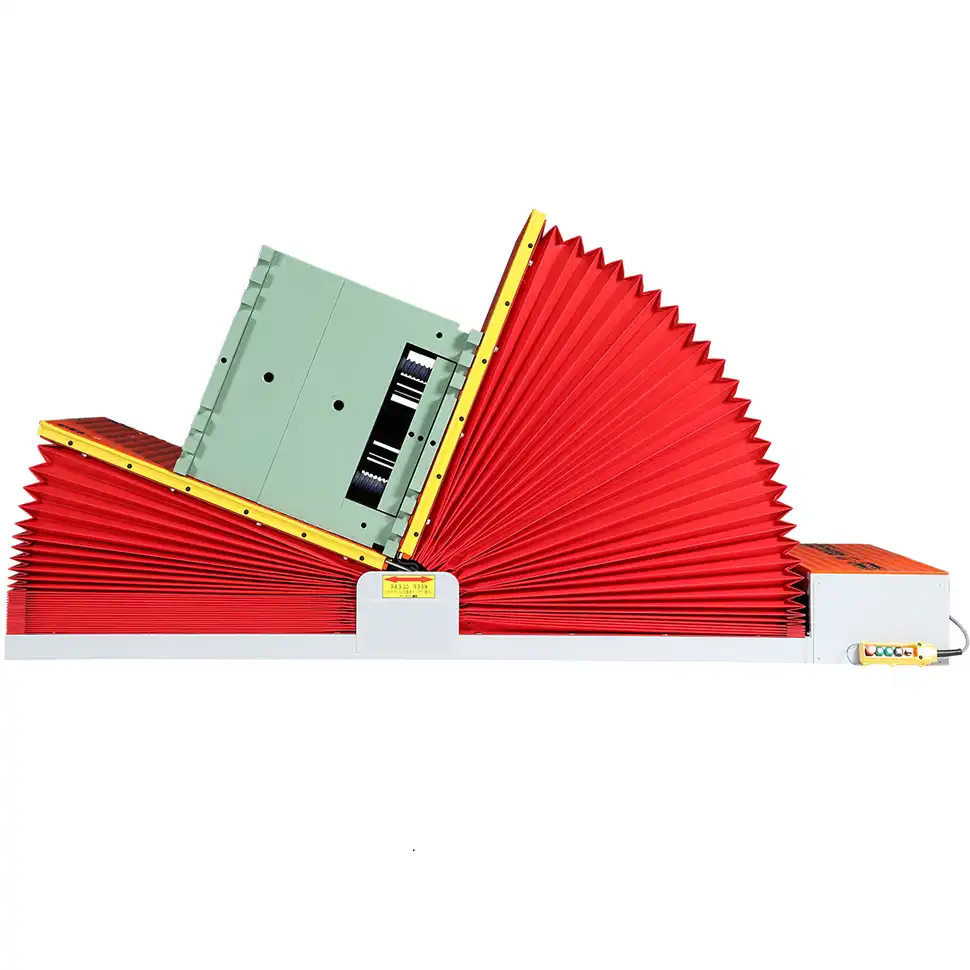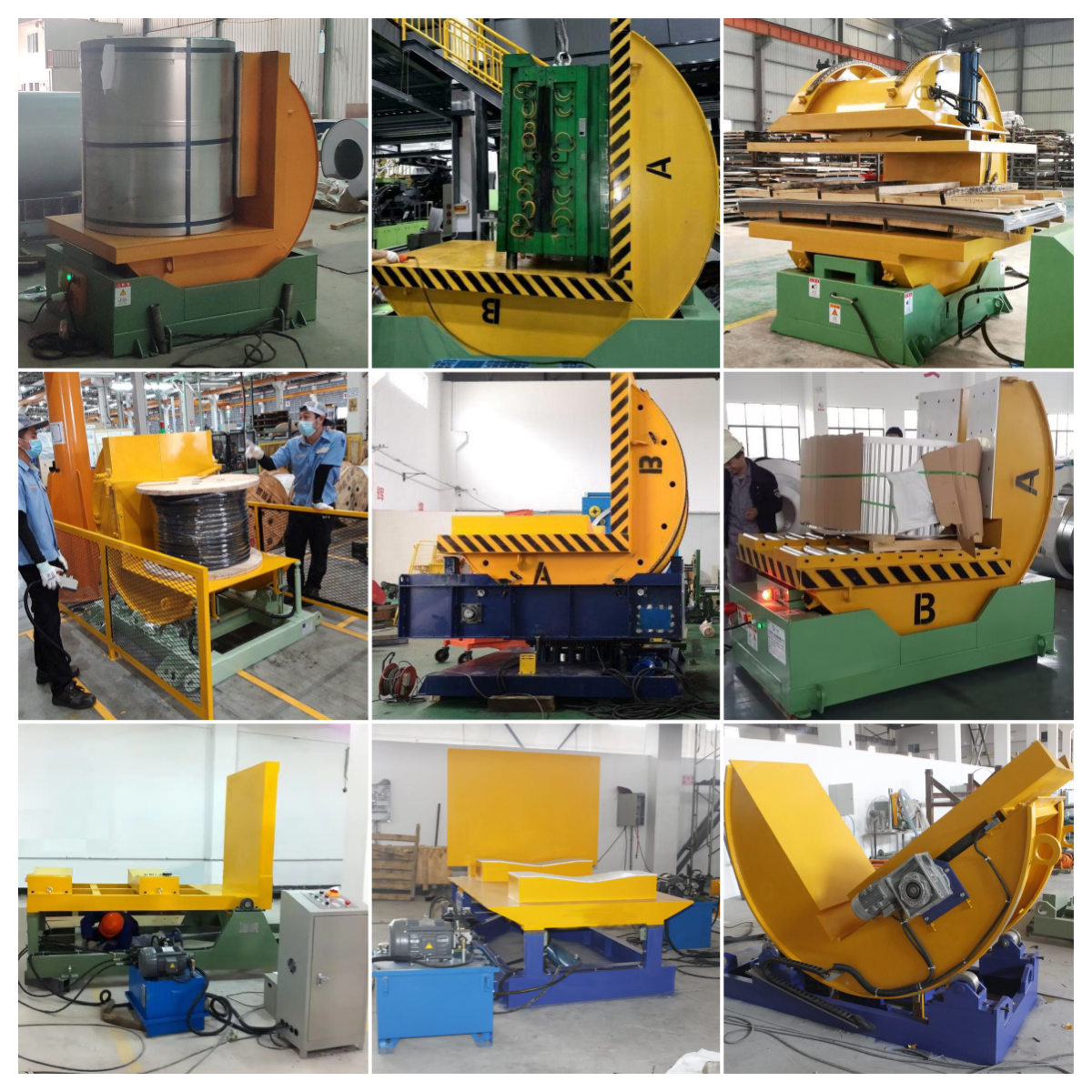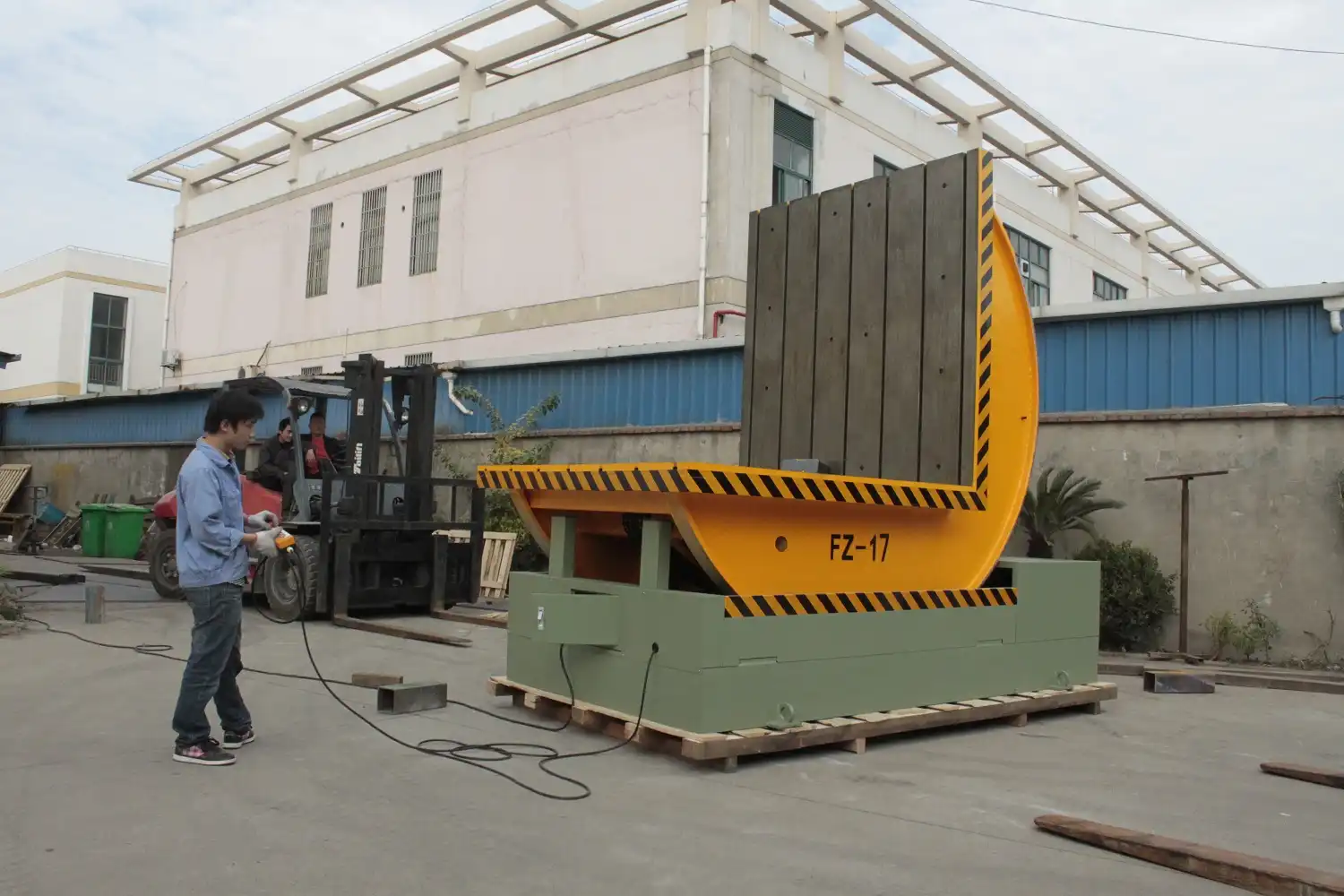What Should U.S. Procurement Teams Look for When Buying a Mold Tilter?
Buying a heavy-duty machine like a mold tilter feels like a major decision. It is. A wrong choice can lead to more than just buyer's remorse. It can create serious safety hazards on your plant floor, cause frustrating production bottlenecks, and lead to thousands of dollars in unexpected downtime. Imagine your team's workflow grinding to a halt because a new piece of equipment failed under load or didn't meet OSHA safety standards. That investment quickly becomes a liability. In my journey from an engineer on the factory floor to owning my own packing machine factory, I've seen this happen. That's why I want to share my experience. This guide will give you a clear checklist to help you choose a mold tilter that is safe, efficient, and a true asset for your U.S. operations.
When buying a mold tilter, U.S. procurement teams must look beyond the price tag. Focus on robust safety features that comply with OSHA regulations, a durable drive system (mechanical or hydraulic) matched to your specific load capacity and duty cycle, and a supplier who acts as a long-term partner. This partnership includes providing detailed technical documentation, U.S.-based after-sales support, and a clear plan for spare parts availability.

These key points are the foundation of a smart purchase. But the real value comes from understanding the details behind each one. A cheap machine can be the most expensive one you ever buy if it fails. Let's break down what truly matters when you're investing in equipment that needs to run safely and reliably for the next 15 to 20 years.
How does a mold tilter's design impact operational safety and efficiency?
All mold tilters flip heavy objects. That is their basic function. But how they perform that function is what separates a reliable workhorse from a constant headache. The core design of the machine directly determines if it will be a safe and efficient part of your production line or a dangerous weak link. A poorly designed tilter can have jerky, uncontrolled movements. It might have dangerous pinch points or lack the emergency safety features your team relies on. This not only slows down your entire process but, more importantly, it puts your operators at risk. Now, let's look at the specific design elements, like the drive system and safety interlocks, that make a machine a high-performance tool instead of a high-risk liability.
A mold tilter's design directly impacts safety and efficiency through its core components. The drive system, whether hydraulic for heavy loads or mechanical for precision, dictates performance. Its structural integrity ensures stability under load, and its integrated safety features, such as limit switches, emergency stops, and physical guards, are essential for preventing accidents and ensuring smooth, predictable operation.

Deeper Dive: The Engineering Behind a Safe and Efficient Tilter
When my team and I design a piece of equipment, we don't just think about what it does. We think about how it will be used for the next two decades. For a mold tilter, this means focusing on three critical areas: the drive system, the structural frame, and the safety systems.
Drive Systems: Choosing Your Power Source
The choice between a hydraulic and a mechanical (or electromechanical) drive system is fundamental. Neither is "better" in all situations; the right choice depends entirely on your specific application in your U.S. facility.
| Feature | Hydraulic Drive System | Mechanical Drive System (Chain/Screw) |
|---|---|---|
| Power | Excellent for very heavy loads (>50 tons). Delivers high torque smoothly. | Best for light to medium loads (<50 tons). |
| Control | Can be prone to jerky movements if not well-engineered. | Offers very precise, repeatable positioning and smooth speed control. |
| Maintenance | Requires regular checks for fluid leaks, filter changes, and hose integrity. | Requires lubrication of chains/gears and checks for wear and tear. |
| Footprint | Requires a separate hydraulic power unit, which takes up floor space. | More compact and self-contained. |
| Environment | Risk of oil leaks, which can be a safety and environmental hazard. | Cleaner operation with no risk of fluid spills. |
I remember a client in the steel industry who initially insisted on a mechanical tilter for a 60-ton mold because they wanted to avoid hydraulics. We had to explain that a mechanical system for that weight would require an enormous gearbox and motor, making it inefficient and extremely expensive. We designed a hydraulic system with multiple redundant safety valves and a robust containment basin, which gave them the power they needed and the safety they required.
Structural Integrity: The Machine's Backbone
The frame of the tilter must be absolutely rigid. Any flexing under load is a sign of poor design. This can lead to premature component failure and unpredictable tilting. We use Finite Element Analysis (FEA) software on every design to simulate the stresses of a full load. This shows us exactly where reinforcement is needed. A fully welded, heavy-gauge steel structure is almost always superior to a bolted frame, which can loosen over time. The location of the center of gravity of your mold is also critical. A good supplier will ask for the dimensions of your heaviest and most awkwardly shaped molds to ensure the tilter remains stable through the entire 90-degree or 180-degree rotation.
Essential Safety Features for U.S. Operations
Meeting OSHA standards is not optional. A well-designed tilter integrates safety from the ground up. This includes:
- Emergency Stop Buttons: Placed in easily accessible locations on the machine and on the remote control.
- Limit Switches: These prevent the tilter from over-traveling in either direction, protecting the machine and the load.
- Mechanical Locking Pins: Essential for maintenance. They allow you to lock the machine in a specific position, ensuring it cannot move while a technician is working on it.
- Audible and Visual Alarms: A horn and a flashing light that activate before and during operation to warn personnel in the area.
- Remote Controls: Keeping the operator at a safe distance from the load is one of the best safety features you can have.
Safety isn't a feature; it's a prerequisite. A failure here is a failure of the entire machine.
What customization options are critical for a U.S. steel mill's specific needs?
Every factory floor is different. You have a unique layout, specific mold or die sizes, established workflows, and different crane capacities. A standard, one-size-fits-all mold tilter rarely fits perfectly into a complex environment like a steel mill. Trying to force a standard machine into your process can create new problems. It might waste valuable floor space, create inefficient handling steps, or even require you to make expensive modifications to your facility or other equipment. This is where a true manufacturing partner shines. A good supplier won't just sell you a product; they will work with you to engineer a solution. Let's explore the most important customization options that will make the tilter feel like a seamless, integrated part of your operation from day one.
For a U.S. steel mill, critical customization options include adjusting the working table size and load capacity to handle specific molds or coils, integrating the tilter with conveyor systems for automation, and tailoring the electrical controls to match U.S. voltage standards (e.g., 480V/3-phase) and interface with plant-wide control systems like an MES.

Deeper Dive: Making the Machine Fit Your Factory, Not the Other Way Around
Customization is not about adding unnecessary bells and whistles. It's about precision engineering to solve your specific challenges. In my experience, a few hours spent discussing customization before the build can save hundreds of hours of frustration and inefficiency over the life of the machine.
Tailoring the Physical Footprint and Function
The physical form of the tilter is the most common area for customization.
- Table Size and Shape: The platform that holds your mold must be a perfect match. Is your mold square, rectangular, or irregular? We often build custom tables with specific locators or clamps to hold a customer's unique part securely. For steel mills handling coils, we build V-shaped saddles directly onto the tilting table to cradle the coil safely.
- Load Capacity: Never guess. Provide the maximum weight of the heaviest object you will ever need to tilt. A responsible manufacturer will then design the machine with a safety factor, typically 125% of your stated maximum load.
- Turning Angle: Most applications only need a 90-degree tilt. But some processes, like mold inspection or maintenance, require a full 180-degree flip. This requires a different mechanical design and should be specified upfront.
- Low Profile Design: I once had a client with very low ceiling height in their tool and die shop. Their overhead crane couldn't lift molds high enough to clear a standard tilter. We designed a custom "pit-mounted" tilter where the base of the machine sat in a shallow recess in the concrete floor. This lowered the overall loading height by 12 inches and solved their problem completely.
Integration with Your Workflow and Systems
A standalone machine can create an "island of automation" that disrupts flow. True efficiency comes from integration.
- Conveyor Integration: For high-volume operations, the tilter can be designed with powered conveyor rollers on its tables. This allows a mold or workpiece to be automatically loaded, tilted, and then sent to the next station without ever being lifted by a crane. This is a huge step towards the kind of automation that leaders like Javier Morales look for.
- Control System Customization: This is non-negotiable for U.S. facilities.
- Voltage: The machine's motors and controls must be built for the standard U.S. industrial power, typically 480V, 60Hz, 3-phase. Using a transformer on a machine built for other standards is an inefficient and often problematic workaround.
- Control Panel: Do you want the controls mounted on the machine, on a separate pedestal, or a combination of both?
- MES/SCADA Integration: For a fully digital factory, the tilter's control system can be designed to communicate with your Manufacturing Execution System (MES). It can receive commands and report its status, cycle counts, and any fault codes, providing valuable data for your production and maintenance teams.
Customization is a conversation. A good supplier will ask you more questions than you ask them. They will want to see drawings of your molds, photos of your facility, and understand your entire process before they recommend a final design.
How can you verify a supplier's long-term support and service capabilities?
The sales process is always smooth. Every supplier promises great service and long-term support. But what happens two years later, when you have a breakdown during a critical production run and you need a spare part shipped overnight? What happens when your local maintenance team has a question they can't answer? A supplier who is great at making promises but poor at keeping them can leave you completely stranded. Your production stops. Costs skyrocket. The initial "good deal" you got on the machine becomes meaningless. I built my company, SHJLPACK, on the belief that a supplier must be a long-term partner. The relationship starts with the sale; it doesn't end there. Let's look at the concrete evidence you should ask for to verify a supplier's support claims before you sign a purchase order.
You can verify a supplier's long-term support by demanding tangible proof. Ask for client references in the U.S. and actually call them. Review their standard warranty documents and service level agreements (SLAs) in detail. Confirm they have a U.S.-based technical support team and a domestic inventory of critical spare parts. Finally, insist on receiving comprehensive documentation, including detailed manuals, electrical schematics, and hydraulic diagrams, with the machine.

Deeper Dive: Separating Promises from Reality
Trust is earned, not given. When you're vetting a supplier for a piece of capital equipment that should last 20 years, you need to do your homework. Here is how I advise my clients to test a potential supplier's commitment to service.
The Reference Check: Go Beyond the List
Any supplier can give you a list of happy customers. Your job is to dig deeper.
- Ask for references in your industry and your country. A reference from a steel mill in Ohio is far more valuable to you than one from a food processing plant in Europe.
- Ask for specific contacts. Don't just talk to the procurement manager who bought the machine. Ask to speak with the maintenance supervisor or the lead operator who uses it every day.
- Ask the right questions.
- "How was the installation and commissioning process? Did the supplier's technicians seem knowledgeable?"
- "Have you ever had to call for technical support? How long did it take them to respond?"
- "Have you needed to order spare parts? What was the lead time?"
- "Was the documentation (manuals, drawings) clear and useful?"
The answers to these questions are more revealing than any sales brochure.
The Documentation Test: A Window into Their Professionalism
I believe that the quality of a company's documentation reflects the quality of their engineering. A professional supplier will provide, without question, a complete set of documents in English. This must include:
- Operator's Manual: Detailed instructions on how to run the machine safely.
- Maintenance Manual: A schedule for preventive maintenance, lubrication points, and troubleshooting guides.
- Electrical Schematics and Hydraulic/Pneumatic Diagrams: These are absolutely critical. Without these drawings, your in-house maintenance team is working in the dark. A supplier who is hesitant to provide these is a major red flag.
- Bill of Materials (BOM): A list of all major components, including the manufacturer and part number for common items like motors, bearings, and sensors. This allows you to source common wear parts locally if needed.
The Spare Parts Plan: Prepare for the Inevitable
Every machine will eventually need a spare part. A great partner helps you prepare for this.
- Ask for a "Recommended Spare Parts List" with your quote. This list should be divided into critical parts (keep on-site) and standard parts (can be ordered). It should include prices and lead times for each item. A supplier who can't provide this quickly probably doesn't have a well-organized support system.
- Ask where their parts are warehoused. For a U.S. customer, a supplier with a North American parts depot is a huge advantage. Waiting for a critical part to ship from overseas can mean weeks of downtime. This is a key differentiator between a global company and a company with a true global presence.
Your due diligence on service and support is just as important as your analysis of the machine's technical specifications. A great machine with poor support is a poor investment.
My Take: What Are the Hidden Costs Beyond the Initial Purchase Price?
When I first started as an engineer, I was focused on design and function. As I moved up and eventually started my own factory, I learned a tough lesson: the most important number is not the one on the price tag. Every procurement team is trained to compare the initial purchase price. It’s the easiest number to see and to put on a spreadsheet. But over my 20+ years in this industry, I've seen that initial price is often the least important factor in the long run. Focusing only on that number can lead you to buy a machine that consumes enormous amounts of energy, requires constant maintenance, or uses proprietary parts that are incredibly expensive. Your "cheaper" machine quickly becomes a money pit. The true cost of a machine is revealed over its entire life. Let me share the factors that determine the real, long-term value of your investment. This is something a simple quote will never show you.
The biggest hidden costs of a mold tilter go far beyond the initial purchase price. You must account for the total cost of ownership (TCO), which includes freight and installation, operator training, ongoing energy consumption, and scheduled maintenance. More importantly, you must factor in the massive cost of unplanned downtime and the long-term availability and price of spare parts.

Deeper Dive: Calculating the Total Cost of Ownership (TCO)
A sophisticated buyer like Javier Morales doesn't just look at capital expenditure (CAPEX); he looks at operational expenditure (OPEX). The TCO is the true measure of an investment. Let's break it down.
The TCO Framework
| Cost Category | Key Considerations for a Mold Tilter | Why It Matters |
|---|---|---|
| 1. Acquisition Costs | Purchase price, taxes, freight to your U.S. facility, rigging and installation fees. | This is the number everyone sees, but it's only the tip of the iceberg. |
| 2. Operating Costs | Energy consumption (motor kW rating), consumables (hydraulic oil, grease), operator labor. | An energy-efficient motor can save you thousands per year. An easy-to-use machine requires less operator time. |
| 3. Maintenance Costs | Cost of recommended spare parts, planned maintenance labor (your team or contractor), cost of lubricants. | A well-designed machine with high-quality components requires less frequent and less costly maintenance. |
| 4. Downtime Costs | This is the big one. Lost production revenue per hour x hours of downtime. Cost of idle labor. Potential for missed shipment penalties. | A cheap, unreliable tilter can cost you more in one day of downtime than the savings on its purchase price. |
| 5. End-of-Life Costs | Cost to decommission and remove the machine. | A minor factor, but still part of the total picture. |
When you get quotes from different suppliers, ask them for the motor specifications and recommended maintenance schedules. You can then use your own data on labor rates and electricity costs to build a TCO model. The "cheapest" machine on paper may end up being the most expensive after five years.
The Hidden Cost of Inefficiency
This is harder to quantify but just as real. Consider a tilter with a slow cycle time. If it takes an extra 30 seconds to tilt a mold and you perform this action 100 times a day, that's nearly an hour of lost time every day. Over a year, that adds up to weeks of lost productivity. Consider a machine with poor ergonomics that requires an operator to be in an awkward or unsafe position. This leads to fatigue, mistakes, and potential injuries—all of which have significant costs.
The Value of a Future-Proof Design
The final hidden cost is the opportunity cost of buying a "dumb" machine. A modern, well-engineered tilter can be a valuable data source. By adding simple IoT sensors, you can track cycle times, monitor motor health, and predict maintenance needs. This aligns with the goal of any forward-thinking leader to implement predictive maintenance and increase uptime to 95% or more. A machine that can integrate with your MES is not just a tilter; it's a node in your smart factory network. It might have a slightly higher initial price, but its value in a data-driven operation is exponentially higher. This is the difference between buying a tool for today and investing in a platform for tomorrow.
Conclusion
A mold tilter is more than steel and motors. It is a long-term investment in your plant's safety, efficiency, and future. Choose your manufacturing partner as carefully as you choose the machine itself.





